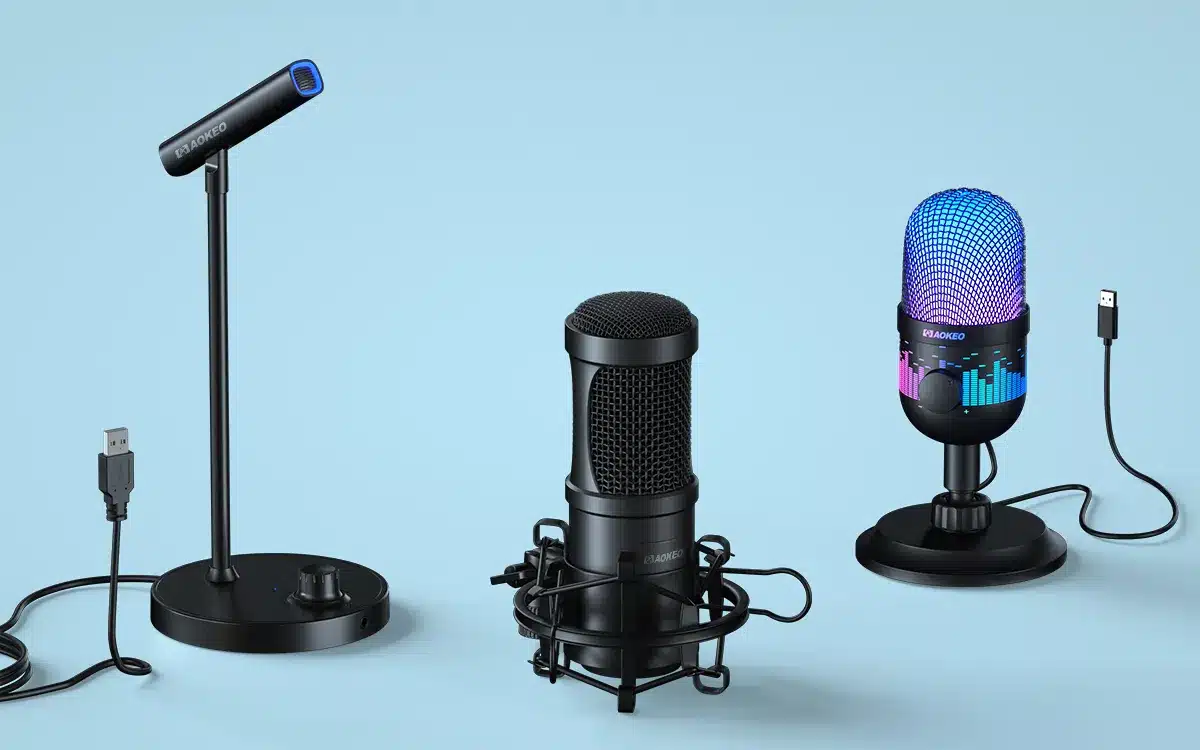Aokeo
Newsletter
Receive access to products and news.
Will be used in accordance with our Privacy Policy
Receive access to products and news.
Will be used in accordance with our Privacy Policy

Microphones may seem deceptively simple, but different scenarios demand drastically different approaches to sound capture. Choosing the wrong mic can lead to poor audio quality, background noise, or even compromise the quality of your content.
This article breaks down the best-suited microphone types for 6 common use cases, helping you navigate the selection process with confidence.
Let's check if you're one of them: Studio Recording, Live Streaming, Podcasting, Outdoor Filming, Live Performances, Meetings, or ASMR Recording.
Sound Quality First
Recommended Microphone: Condenser Microphone
Condenser microphones excel in sensitivity and wide frequency response (typically 30dB to 10dB), capturing nuanced details in vocals and instruments, which explains their status as studio staples.
Ideal for: Singers, voice actors, instrumental recordings.
Classic models: Neumann U87, AKG C414.
Tips: Requires an audio interface and phantom power. Use in a soundproofed environment (e.g., treated with acoustic foam, isolated from ambient noise like HVAC hum or traffic), or improvise with portable solutions like reflection filters or vocal shields.
Balancing Convenience and Quality
Recommended Microphone: USB Condenser Microphone
Plug-and-play USB microphones (often USB-C compatible) eliminate the need for external audio interfaces, offering one-click connectivity for seamless podcasting, remote conferencing, or multi-person recordings.
Their built-in analog-to-digital converters and optional headphone monitoring cater to creators prioritizing portability, while adaptive polar patterns accommodate scenarios from gaming commentaries to working meetings.
Best for: Gaming streams, tutorials, remote interviews.
Affordable picks: Blue Yeti, Aokeo AK-1i.
Pro tips: Add a pop filter to minimize plosives, and use a mic boom arm to save desk space.
Battling Background Noise
Recommended Setup: Shotgun + Lavalier Combo
The shotgun microphone captures directional audio with high off-axis rejection, minimizing wind and traffic interference when paired with a furry windscreen.
Simultaneously, the lavalier ensures consistent voice clarity for moving subjects, while wireless transmission avoids cable rustle.
This dual-system approach provides redundancy for post-production editing in unpredictable environments.
Classic models: Rode NTG5, Sennheiser AVX.
Pro tips: Always use a windscreen to block wind noise outdoors. For extreme environments like beaches or mountain ridges, pair physical windshields with post-processing tools.
Bonus: Keep backup lavaliers in waterproof cases – sudden storms won't ruin your dialogue tracks!
Durability and Feedback Resistance
Recommended Microphone: Dynamic Microphone
Dynamic microphones are renowned for their durability and ability to withstand extreme sound pressure levels, making them ideal for live performances and loud stage environments.
Their robust construction, often featuring a moving coil design, minimizes feedback and distortion even when capturing powerful sound sources like amplified instruments or aggressive vocals.
Unlike more sensitive condenser mics, dynamics require no external power and excel in high-volume scenarios, from rock concerts to public announcements. These qualities also make them a popular choice for handheld use in vocals, drum miking, and outdoor events where reliability and noise rejection are critical.
Classic models: Shure SM58 (vocals), SM57 (instruments).
Pro Tip:
Clear Audio for Multiple Speakers
Recommended Microphone: Omnidirectional or Boundary Microphones
For collaborative spaces where voices flow from all directions, these two microphone types deliver conference-ready clarity:
Omnidirectional Mics
Boundary Mics (Surface-Mounted)
Omnidirectional mics mimic human ear’s spatial awareness, while boundary mics weaponize physics – turning tables into soundboards. Together, they solve the "mumbler vs. megaphone" paradox in unscripted meetings.
Pro Tip: For large rooms, pair multiple mics or ceiling-mounted arrays.
Capturing Subtle Sounds
Recommended Microphone: Dual-Diaphragm Condenser
Featuring two back-to-back diaphragms and phase-inversion technology, this microphone enables flexible polar pattern switching.
Its ultra-thin gold-sputtered diaphragms deliver exceptional sensitivity (15mV/Pa), precisely capturing subtle vibrations across a 20Hz–20kHz frequency range. The dual diaphragms work in tandem to create lifelike stereo imaging, while the integrated A/D converter’s 128dB dynamic range resolves even 0.1dB loudness variations in ASMR triggers.
Ideal for immersive audio requiring spatial localization, such as recreating 3D whisper environments or capturing the delicate acoustic pathways of falling leaves.
Popular choices: Rode NT5
Pro Tip: Record in silent spaces with shock mounts to eliminate handling noise.
If your work fits any of these scenarios, choosing the right mic can make or break your audio. Time to upgrade your toolkit!
No account yet?
Create an AccountGet notified about Aokeo products, news, and events.